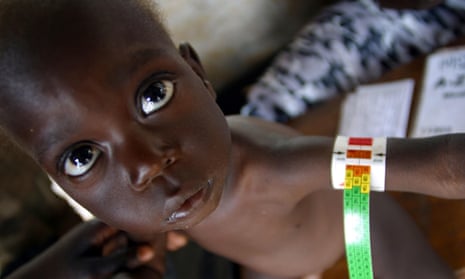One of the final acts in the lengthy process of creating a new set of global sustainable development goals (SDGs) was completed last weekend when world leaders formally adopted 17 goals and 169 targets. But for those of us who seek to tackle the world’s collective failing in ensuring adequate nutrition for all, the battle is just beginning.Draft indicators for each target, which will measure the achievements of the SDGs, will not be finalised until next March. When they have been agreed, we should be in a better position to judge whether the SDGs are adequate to address one of the world’s foremost health challenges: the triple burden of malnutrition (or undernutrition), micronutrient deficiencies and overweight/obesity.
Globally, levels of hunger and undernutrition remain unacceptably high, with one in nine people worldwide suffering from chronic hunger and close to 2 billion overweight and obese. Undernutrition is responsible for the deaths of some 3 million children each year.
We feel there should be three priorities as we drive the fight against malnutrition forward. First, the assumption that nutrition and hunger are the same must be challenged. The SDGs, unlike the millennium development goals (MDGs), strongly link hunger and nutrition. The goal of ensuring adequate nutrition could easily be missed because of a commonly held assumption that hunger and nutrition are the same thing. This must be challenged because it privileges action on hunger over nutrition.
Evidence shows that governments in Bangladesh, Nepal, Malawi, Zambia and Tanzania rarely show the same political commitment to addressing inadequate nutrition as they do to tackling hunger. This may be because popular conceptions of hunger are clearer, and historically it has been a political rallying point. But overcoming the triple burden of malnutrition is not only about better food security, but also about more sustainable and healthy diets, better systems of support for mothers and infant care, and better health and sanitation.

Second, the new SDG indicators should adopt existing World Health Assembly indicators. While it is positive that goal 2 explicitly promises to “end hunger, achieve food security and improved nutrition, and promote sustainable agriculture” by 2030, achieving a good set of nutrition-relevant indicators is critical. This is how we can guarantee action at country level. Many nutrition advocates, including prominent UN bodies, have argued for the adoption of the indicators already agreed by health ministers at the 2012 WHA. As it stands, “nutrition” is still buried within the goals and targets of the SDGs.
While stunting in children – an important measure of overall child growth and development that was missing from the MDGs – is included, other WHA indicators, which try to capture the complexity of nutrition and its determinants, are missing. These include child wasting, rates of exclusive breastfeeding, and anaemia in girls. An additional indicator on women’s dietary diversity is being promoted by some UN agencies. At least the WHA indicator on childhood obesity is in there. But we should go further in tracking obesity in both children and adults. Obesity is often a driver of non-communicable diseases (NCDs), such as diabetes. NCDs rightly feature in the high-level political goals, but so should obesity. One wonders at the politics which led to its relegation to the technical indicators rather than the political goals.
Third, the collection of good quality data is critical. The decisions on the indicators will drive global data collection efforts, policy debates and interventions over the coming 15 years. Good quality internationally comparable data is desperately needed to tackle malnutrition. This requires systematic monitoring of both efforts and outcomes by governments, development partners, civil society and researchers. Because the results of the SDGs will take time to materialise, data on government efforts, such as policies, laws and investment, must be closely monitored.

International rankings such as the Institute of Development Studies’ Hunger and Nutrition Commitment Index (Hanci), launched today, already work to foster greater accountability. Hanci measures political commitment to tackling hunger and undernutrition in 45 developing countries by looking at available data on government spending, policies and legal frameworks. This approach is an example of how to assess SDG progress, alongside critical work being carried out to assess wider progress on nutrition, such as the recently launched global nutrition report.
To effectively address malnutrition over the coming decades, we must monitor efforts and outcomes at a technical level and demand profound political commitment to this drive. Only then will the battle against malnutrition find its place in the “all in it together” universalism that has been hailed as the radical new approach at the heart of the SDGs.
- Dolf te Lintelo and Nick Nisbett are research fellows at the UK’s Institute of Development Studies
